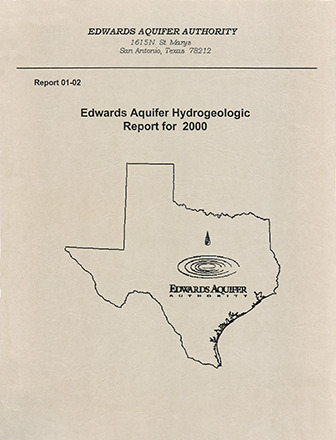Edwards Aquifer Hydrogeologic Report for 2000

| Author | Esquilin R, Lillibridge BC, Mahula DM, Mireles J, Hoyt JR and Schindel G |
| Year | 2001 |
| Description | Annual report for 2000 on recharge, discharge, water levels and water quality in the Edwards Aquifer San Antonio Region |
| Report Number | 01-02 |
| Publisher | Edwards Aquifer Authority |
| Location | Edwards Aquifer - San Antonio Area |
| Cover | View Download |
| File | View Download |
| Summary |
|
(Excerpted from the report Summary) In 2000, the following minor element metals were detected at or above a drinking water standard (Standards in 40 CFR Part 141, 40 CFR Part 143, and EPA’s lead and copper rules): Lead … Mercury … Cadmium … The cadmium concentrations above the MCL were detected in water samples from freshwater/saline water interface monitoring wells. The lead and mercury concentrations were detected in freshwater wells at concentrations just above the MCL. These wells will continue to be monitored for minor element metal concentrations to assess any trends of concern. Water samples from three freshwater/saline water interface monitoring wells in Bexar County and five freshwater/saline water interface monitoring wells in Hays County contained fluoride concentrations above the MCL of 4.0 mg/L. Water samples from several other wells, primarily freshwater/saline water interface monitoring wells, contained fluoride above the secondary drinking water standard of 2.0 mg/L. These fluoride concentrations are believed to be naturally occurring. Water samples from several wells contained nitrate concentrations above the MDL. However, none of the nitrate concentrations exceeded the MCL. In general, relatively higher nitrate concentrations were detected in the Uvalde area. … The VOC tetrachloroethene (PCE) was detected in a well in Uvalde County (YP- 69-51-114) at a concentration of 7 µg/L. The MCL for tetrachloroethene is 5µg/L. The TNRCC is working with the responsible party to address the tetrachloroethene contamination. … Comal and Hueco springs were sampled numerous times in 2000 in response to a release of approximately 2,800 gallons of diesel fuel from an above ground storage tank. The release occurred in January 2000 on the recharge zone approximately four miles southwest of New Braunfels. VOCs and SVOCs of an unknown origin were detected at Comal and Hueco springs in late January and early February 2000. The VOC and SVOC concentrations were not detected in subsequent samples collected from Comal and Hueco springs. No VOCs or SVOCs were detected at San Pedro or San Marcos Springs. The VOCs and SVOCs detected at Comal Springs were: 2-methyl naphthalene … naphthalene … total xylenes …. The VOCs and SVOCs detected at Hueco Springs were: 2-methyl naphthalene … naphthalene …. The origin of the VOCs and SVOCs detected at Comal and Hueco Springs continues to be investigated. |
Search for Documents
Advance Search
Explore EAA's Scientific Reports
- All Reports
- Overview Studies
- Modeling
- Hydrology and Hydrogeology
- History
- Groundwater Recharge, Recharge Zone
- Groundwater Movement
- Geomorphology and Caves
- Weather Modification
- Geology
- Water Use and Conservation
- Geochemistry
- Water Resources Planning and Management
- Floods and Drought
- Water Quality
- Climatology
- Surface Water / Groundwater Relationship
- Biology
- Springs, Groundwater Discharge
- Archaeology
- RZ Protection
- Aquifer Levels
- Remote Sensing
- Precipitation
